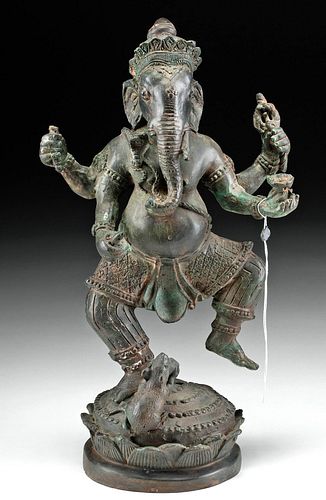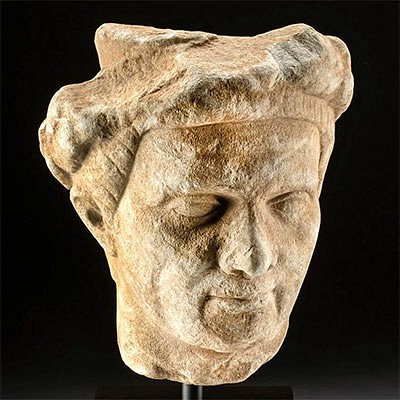20th C. Thai Brass Statue Dancing Ganesh w/ Rat
Lot 97
About Seller
Artemis Fine Arts
686 S Taylor Ave, Ste 106
Louisville, CO 80027
United States
Selling antiquities, ancient and ethnographic art online since 1993, Artemis Gallery specializes in Classical Antiquities (Egyptian, Greek, Roman, Near Eastern), Asian, Pre-Columbian, African / Tribal / Oceanographic art. Our extensive inventory includes pottery, stone, metal, wood, glass and textil...Read more
Categories
Estimate:
$1,600 - $2,400
Absentee vs Live bid
Two ways to bid:
- Leave a max absentee bid and the platform will bid on your behalf up to your maximum bid during the live auction.
- Bid live during the auction and your bids will be submitted real-time to the auctioneer.
Bid Increments
| Price | Bid Increment |
|---|---|
| $0 | $25 |
| $300 | $50 |
| $1,000 | $100 |
| $2,000 | $250 |
| $5,000 | $500 |
| $10,000 | $1,000 |
| $20,000 | $2,500 |
| $50,000 | $5,000 |
| $100,000 | $10,000 |
| $200,000 | $20,000 |
About Auction
By Artemis Fine Arts
Jun 1, 2023
Set Reminder
2023-06-01 10:00:00
2023-06-01 10:00:00
America/New_York
Bidsquare
Bidsquare : Ancient | Asian | Ethno | Native American Art
https://www.bidsquare.com/auctions/artemis-gallery/ancient-asian-ethno-native-american-art-12905
Featuring classical antiquities, ancient, and ethnographic art from cultures encompassing the globe. Egyptian, Greek, Roman, Near Eastern, Asian, Pre-Columbian, Native American, African / Tribal, Oceanic, Spanish Colonial, Fossils, more! All legally acquired, legal to sell. Satisfaction guaranteed. Artemis Fine Arts info@artemisfinearts.com
Featuring classical antiquities, ancient, and ethnographic art from cultures encompassing the globe. Egyptian, Greek, Roman, Near Eastern, Asian, Pre-Columbian, Native American, African / Tribal, Oceanic, Spanish Colonial, Fossils, more! All legally acquired, legal to sell. Satisfaction guaranteed. Artemis Fine Arts info@artemisfinearts.com
- Lot Description
Southeast Asia, Thailand, ca. mid-20th century CE. A cast brass statue of Ganesha, the elephant headed deity known as the "Remover of Obstacles," dancing atop a lotus pedestal. He is attended by a mouse, rat, or shrew next to his feet, and he holds several ritualistic objects or weapons in his four hands. Ganesh's portly state is the result of his well-known infatuation with sweets, and a snake, likely Vasuki, the serpent king, coils around his body. The underside of the hollow base is filled with the remains of brick/ mortar from when this was set in a niche or public shrine, and the surface has some weathering from exposure to the elements. Size: 8" L x 5.5" W x 14" H (20.3 cm x 14 cm x 35.6 cm)
Esteemed as one of the principal deities of the Hindu pantheon, the first son of Shiva and Parvati, Ganesha is known as the Lord of Plenty or the god of auspiciousness, highly revered as the regulator of all obstacles with the power to create and remove them. Followers traditionally ask for his blessings at the beginning of any new paths or serious endeavors. The origin of his unusual physiognomy, particularly how he came to possess such an unusual head is the source of many legends, the most popular is that one day when Shiva was away from home, Parvati created a human son from her own body. She asked her son to guard the door while she was bathing. Quite unexpectedly, Shiva returned home, and the boy would not allow Shiva to enter his own household. Enraged by this, Shiva cut off the boy's head. Parvati grew quite angry and ordered Shiva to replace his head. Shiva did so with the first living being he encountered: an elephant.
Provenance: private Orange County, California, USA collection acquired before 2000
All items legal to buy/sell under U.S. Statute covering cultural patrimony Code 2600, CHAPTER 14, and are guaranteed to be as described or your money back.
A Certificate of Authenticity will accompany all winning bids.
We ship worldwide and handle all shipping in-house for your convenience.
#178922Stable fissure to base. Casting imperfections and abrasions to surface. Loss to implement in upper right hand, tusk and headdress. Green patina and dark toning. Remains of mortar in base adds to the weight of the piece. Old export seal attached by string to his hand as shown.Condition
- Shipping Info
-
All shipping is handled in-house for your convenience. Your invoice from Artemis Gallery will include shipping calculation instructions. If in doubt, please inquire BEFORE bidding for estimated shipping costs for individual items.
-
- Buyer's Premium



 EUR
EUR CAD
CAD AUD
AUD GBP
GBP MXN
MXN HKD
HKD CNY
CNY MYR
MYR SEK
SEK SGD
SGD CHF
CHF THB
THB














